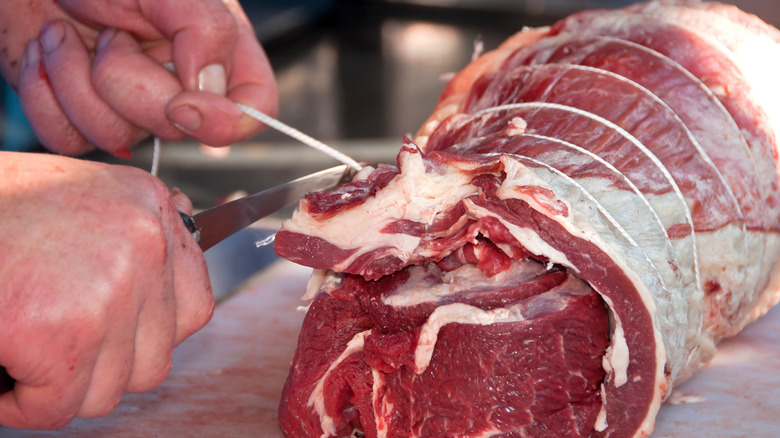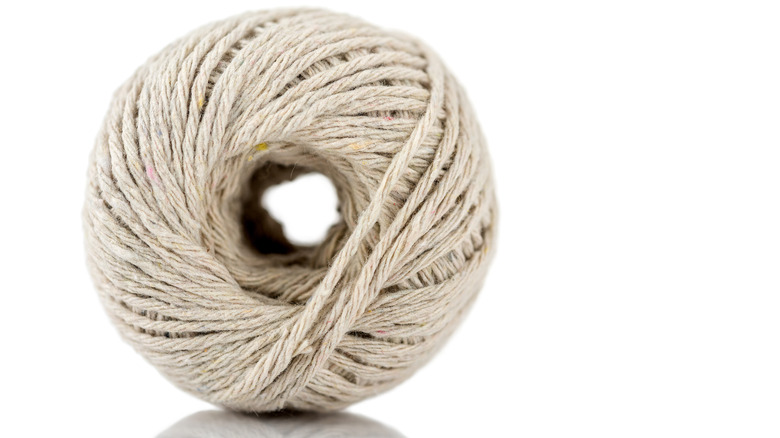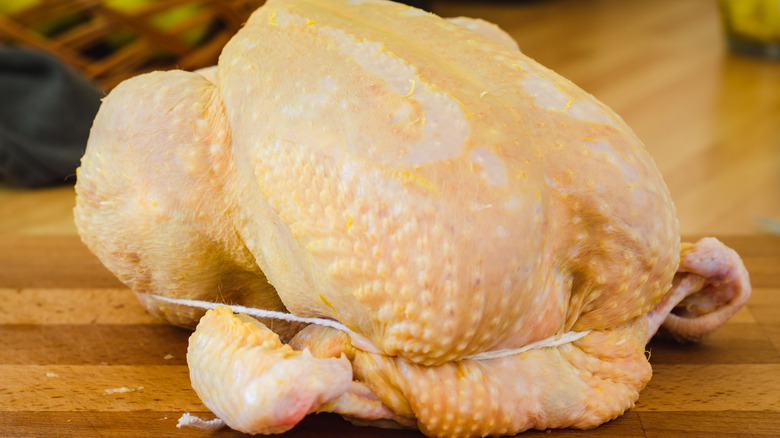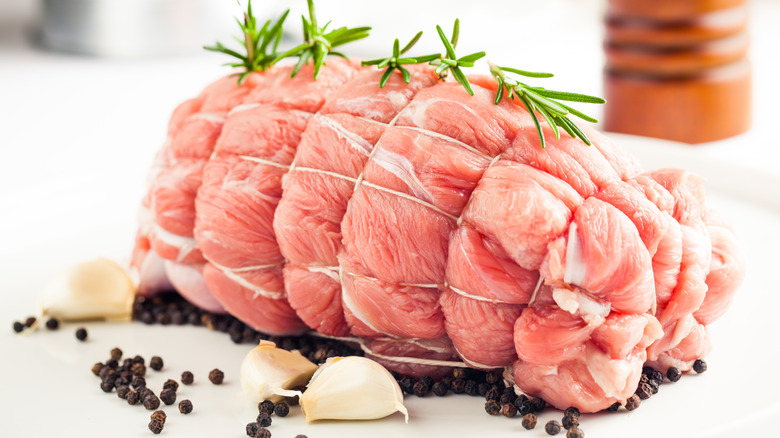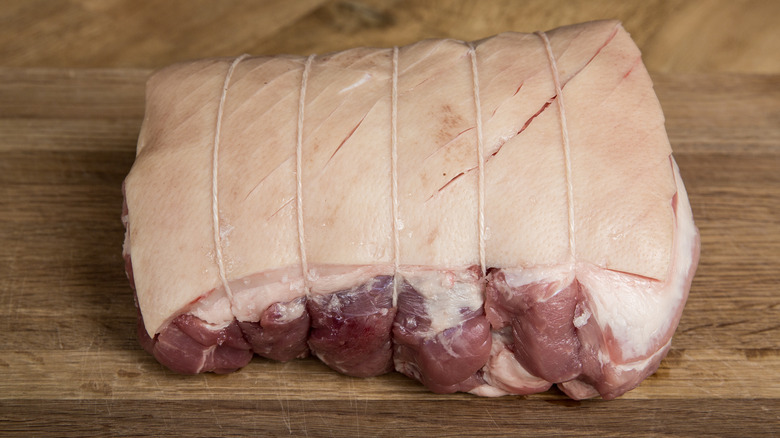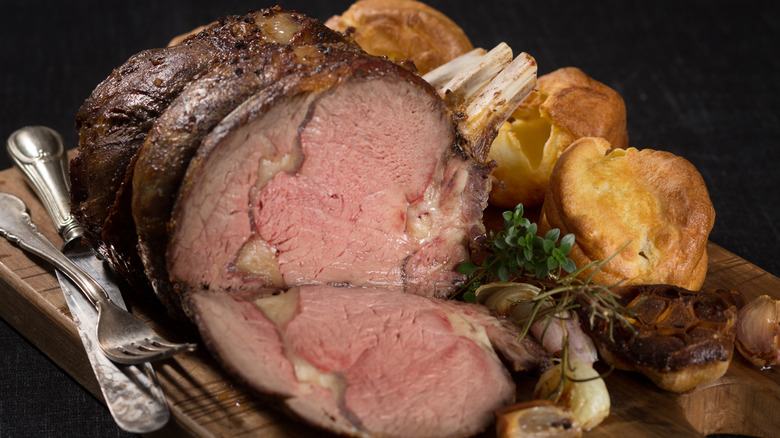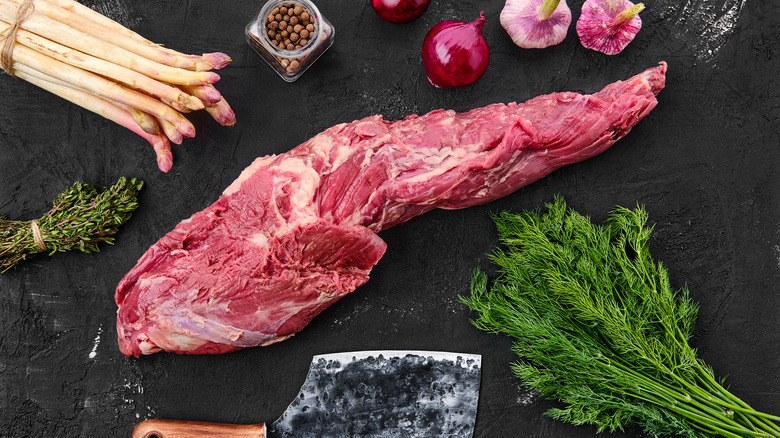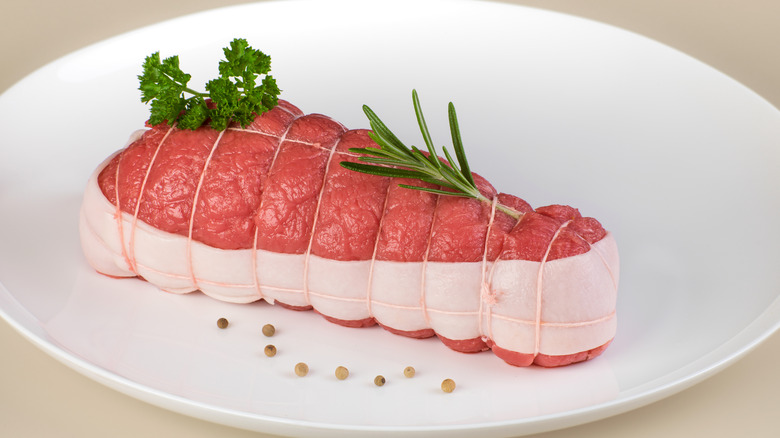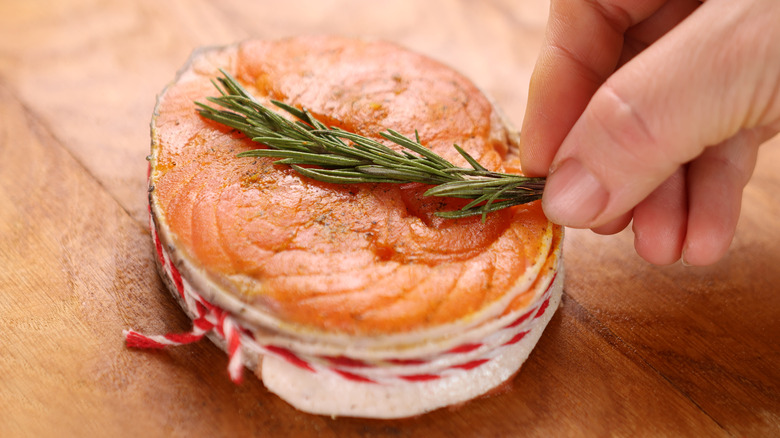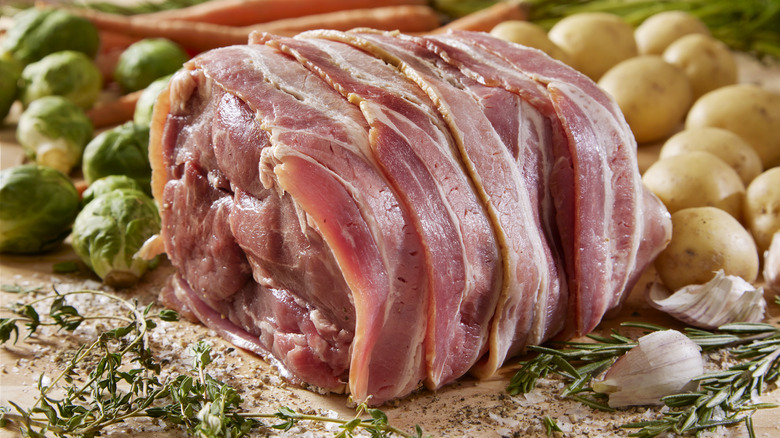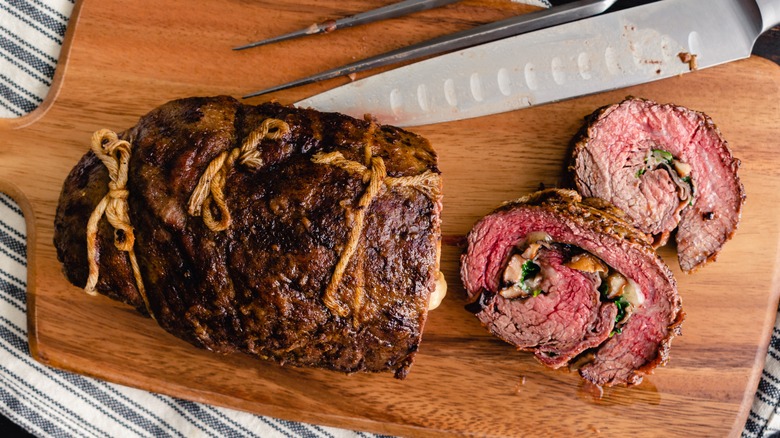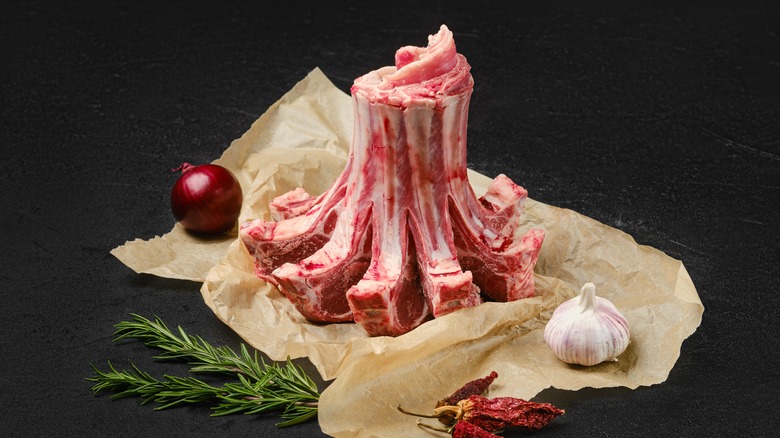A Professional Chef Offers 11 Tips For Trussing Meats
The difference between everyday dishes and professionally prepared meals often comes down to a command of the details. It's those small things that give a meal some polish and give an impression of thoughtful, skilled preparation.
One of those details is trussing. If you've ever brought home a rotisserie chicken from the store, you'll know that they're tied up neatly to hold the bird in a tight, compact shape. Your favorite butcher probably does the same with a lot of boneless roasts, especially those big, showy crown roasts of pork or lamb. It gives the meat a neat and professional look — but more importantly, trussing helps the protein cook evenly, keep its shape, and (in the case of poultry) avoid burnt wingtips.
You may know trussing as something chefs and butchers do, but it's a skill set that anyone can acquire. As a trained chef — and someone who's always been "knot-challenged" — I can assure you that it all comes down to practice. That being said, here are a few useful tips and tricks that can make trussing easier for you.
Use the right twine for trussing your meats
Like any other kitchen task, successfully trussing a roast or a bird requires the correct tool. In this case, that's twine. You can't just use any old string you have kicking around the house because not all of them work well, and some may contain unpleasant or potentially harmful compounds.
The best kind of twine for trussing birds is cotton twine, aka butcher's or kitchen twine. It's often white or off-white in color. The twine is soft and flexible, easy to tie, and not expensive. Hemp and linen are also excellent choices, though they may command a premium price. You can usually even make do with dental floss or silk sewing thread in a pinch, though these options are so thin that they may cut into tender poultry or fish. Choose a white thread since dyes aren't necessarily food-safe.
Synthetic twine is more problematic because it may melt in the oven. Some kinds of polyester twine are food-grade and are manufactured and labeled for this specific use, but otherwise, you should avoid them.
If you have some string in a kitchen drawer and you aren't certain as to whether it's natural or synthetic, try lighting the end of it outside (since the fumes can be particularly nasty). If it smolders and burns, it's probably a natural fabric. But if it melts, it's synthetic, and you should avoid using it.
Try a simplified version of chicken trussing
Let's be clear: You can roast a perfectly good chicken without trussing it. That said, there are a lot of good reasons why trussing is valuable. It keeps the bird neat and easy to handle, so if you turn it during roasting, it won't fall apart. Trussing helps keep aromatics in the cavity or under the skin as the bird roasts. Plus, securing legs or wingtips prevents them from sticking to the roasting pan. Trussing is also helpful if you're cooking your chicken in a rotisserie since it means the legs and wingtips won't burn or stick to the heating elements.
If you want to avoid burnt chicken bits, you can try Martha Stewart's technique of tucking the bird's wings behind it and securing the string by using the neckbone and tail as anchors. Some go even further and use a trussing needle to sew the cavity closed or pass the twine through sturdy cartilage. These techniques aren't as intimidating as they sound, and most people can get a handle on the process after a few attempts.
But there is a shortcut way to truss your chicken that works equally well. You can simply tie up the legs with one piece of twine and then tie up the wings separately with a second one. The end result is almost identical to more complex methods, and it requires a lot less wrestling with a slippery, raw chicken.
Single loops are easier than continuous knots
There are many arguments in favor of trussing chicken, and they're even more compelling when it comes to roasts. A well-trussed roast has a compact and uniform shape that will cook more evenly. In the case of roasts where a large bone has been removed, trussing can be the only way to have it hold together properly.
As with poultry, there's a classic trussing technique that looks beautiful but requires some skill. It's called a continuous knot. Each loop around the roast is connected to the rest, and the twine makes a connecting line between each loop. This knot is quite effective at holding the roast together, and you won't have to worry about cutting the twine until you're done. But there are other ways to tie up your roast that are simpler and just as efficient.
You can start by making a loop around your roast, tying it tightly with whatever knot you can comfortably make, and then cutting the twine. Then, you'll repeat this until you've made as many loops as you need to hold the roast firmly together. If necessary, run another loop lengthwise across those loops to keep the ends neatly tucked in. That's it! There's no skill or finesse involved, but your roast will still have the right shape and structure — and that's what counts.
Start trussing large cuts in the middle
One thing you'll quickly learn when you start trussing roasts — especially floppy deboned ones like a chuck, pork shoulder, or leg of lamb — is that wrestling with a big slab of slippery meat can be frustrating. This simple tip can avoid the aggravation.
The key to trussing large cuts is to start in the middle. These roasts usually have several muscles running in different directions, which adds up to a lot of moving parts when you start trussing. If you start at one end, it's hard to keep the other end from becoming misshapen before you get there. If you start in the middle instead, you've just immobilized the place where things start to go wrong.
From there, move out and tie your second and third loops on either side of that first one. Make sure you gather all of the muscles together as neatly as possible before tying each loop, and make them snug enough to hold the meat in place. The number of loops you'll need to keep the whole roast together neatly will depend on its size and overall floppiness, so use your judgment and try to keep them evenly spaced. If you guess wrong, there's no shame in cutting a loop or two and putting your new ones closer together.
Trussing a prime rib makes it even better
Trussing the king of roasts, a prime rib, can help you make the most out of this premium cut. Some cooks like to french a bone when prepping cuts of meat for a more dramatic presentation. Frenching a prime rub will also make it easier to carve. You can still tie it back into a neat cylinder, so it will come out looking like a prime rib.
You can use an easy technique to french and truss your meat. Take a thin, sharp knife (a boning knife is ideal) and slide it down the bones to separate them from the meat. Next, tie your twine around the roast, either parallel to the bones or cross them from side to side, and make enough loops to hold the bones and meat together.
To French your prime rib specifically, lay it on your cutting board and look at it side-on. You'll see the main part of the roast, as well as a mostly-fat section covering the ends of the ribs. Slice through the fat right down to the bones and then along the bones to remove it. Cut between the bones and scrape away the membrane to reveal the bone tips. Now, tie loops around the exposed areas of roast between the bones to make it perfectly cylindrical.
Fold a tapered cut back on itself to make it uniform
Some cuts of meat, poultry, and fish are naturally even in shape, while others have a distinct taper. This shape can make them awkward to cook because the thin part will usually be overcooked by the time the thick part is done. Trussing helps you work around that discrepancy.
Suppose, for example, it's a special occasion, and you've spent a pretty penny on a whole beef tenderloin. One end is slightly rounded, the middle is nice and thick, and the other end has a flat taper. If you fold the tapered part back toward the middle, you can bring it to a point where the whole tenderloin is pretty close to the same thickness. Tying up your beef tenderloin before cooking it will ensure that the meat cooks as evenly as possible — and will help you get your money's worth out of the cut.
The same holds true for smaller cuts, like a pork tenderloin. You can truss the whole cut or the individual medallions. If you plan on going with the latter, truss them first and then cut your individual portions. You won't have to guess how many loops of twine to use because you can just use one (or two, if you need to) for each section.
Truss lean or skinless cuts with fat to protect them
Some meats are naturally lean. These include tenderloins, beef rounds, skinless poultry breasts, and game meats like rabbit or venison. It's easy to overcook or dry these cuts out in an oven or on the grill.
Professional cooks have a couple of classic techniques for dealing with this. One is larding, which uses a special needle to pull strips of pork fat into the muscle. The other, called barding, calls for slicing thin sheets from a slab of fatback or pork belly and using your trussing skills to hold them in place around the meat. Ideally, your strips of fat are long enough to go all the way around the meat, so you're not trying to patch them together. For the prettiest presentation, tie your knots where the ends of the strips of fat overlap, and make sure that side goes on the bottom.
It takes a sharp knife and some practice to get those sheets of fat to just the right thinness so they'll fold easily around your roast and render away to a crisp, golden, tasty coating. You may want to explain your plans to your local butcher or supermarket meat cutter and ask if they'll cut the strips for you ahead of time. If you do it yourself, you'll find the meat easiest to cut neatly if it's very cold (nearly frozen) and your knife has a sharp, thin blade.
It's helpful to truss small cuts
Most recipes that call for trussing are centered around whole birds and big roasts, but that doesn't mean you can't truss smaller cuts, too. In fact, now that I cook for two most of the time, most of my twine gets used on these smaller cuts.
Consider filet mignon, for example. It's cut from beef tenderloin, which is both meltingly tender and soft to the touch. When cooked in a skillet or on the grill, it often spreads into an irregular, oblong shape. Trussing each piece helps keep it round and pretty and helps it cook evenly.
You can also truss a deboned piece of pork or lamb and slice across it to make individual chops. This creates the option of making stuffed chops, which usually require some form of trussing to keep the stuffing where it belongs. You can even roll up and tie fish steaks or individual filet portions so the thin belly meat doesn't cook faster than the thicker part of the filet.
Use bacon as an alternative form of trussing
Twine is the default option for trussing meats — but it's not the only one. You may have one popular alternative in your fridge right now: bacon.
Bacon-wrapped scallops and steak prove that bacon can be a valuable substitute for butcher's twine. Bacon naturally contracts as it cooks, so it can neatly hold your meat together. Because it's high in fat, it gives you the protective effects of barding your meat (wrapping it in fat), and of course, it also adds its distinctive sweet, salty, and smoky flavor to the mix.
For a long-cooking roast, you can start with completely uncooked bacon. But for smaller cuts or individual portions, the bacon won't crisp and render its fat before the meat underneath it is fully cooked. Instead, you'll need to use par-cooked strips of bacon. The strips should be floppy enough to still be folded around your protein, whether it be a chicken breast, pork tenderloin, or individual portion (like a filet mignon) taken from a larger cut.
Trussing gives you a chance to amp up your flavors
Think for a moment about the kinds of meat cuts that you'd typically truss. The most common options are whole poultry and boneless roasts, though, occasionally, a cook might take a flat cut like flank steak and roll it up to make a roast.
You can use trussing to crank up the flavor of these cuts and make your meal more special. Start stuffing your chicken with onions, garlic, celery, fresh herbs, or lemon slices, and tie it closed for a flavorful entrée. You might stuff a deboned leg of lamb with garlic and finely minced rosemary or fill a pork roast with herbs and garlic for a classic porchetta.
Those classic examples aren't your only options, either. You can transform a small chicken breast into a walnut-crusted cranberry roulade, or swap your Thanksgiving bird with a turkey roulade with dried cherries and stuffing. Seafood lovers can make stuffed flounder with crab filling to dial up a weeknight meal into something suitable for company.
Sometimes you don't need to truss conventionally (or at all)
As powerful and versatile as trussing is, there are times when you may want to skip it. After all, it is time-consuming and may be difficult to learn at first. Like any other kitchen technique, it can be followed or ignored as you see fit.
For example, with small meals like roulade or stuffed chops, you might look for a pan or a baking dish that will hold the meat tightly enough that each piece will keep the other closed, thus eliminating the need for trussing. Some companies even manufacture specialized meatloaf pans with perforated bottoms to let fat and drippings through. You could use one of those to hold a small boneless roast in shape without trussing it. Even something as big and impressive as a crown roast can be made without twine if you follow Alton Brown's suggestion and roast it in a large bundt pan.
Alternative methods include holding your meat together with toothpicks (for small cuts) or skewers (for large cuts). Just remember to remove them before carving and serving because swallowing one isn't a fun time. If you have access to ethnic grocery stores or international markets, you can even try binding your meat together with strips of corn husks or banana leaves.
